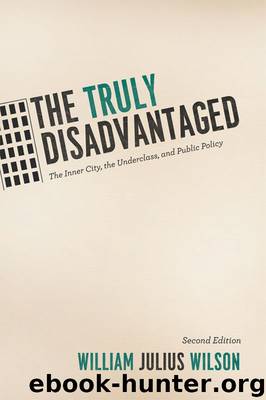The Truly Disadvantaged: The Inner City, the Underclass, and Public Policy, Second Edition by William Julius Wilson

Author:William Julius Wilson [Wilson, William Julius]
Language: eng
Format: epub
Tags: USA, Geografia
Publisher: University of Chicago Press
Published: 2012-06-28T22:00:00+00:00
Notes
Preface
1. Herbert J. Gans, “The Negro Family: Reflections on the Moynihan Report,” in The Moynihan Report and the Politics of Controversy, ed. Lee Rainwater and William L. Yancey (Cambridge, Mass: MIT Press, 1967), p. 449.
Chapter 1
1. Kenneth B. Clark, Dark Ghetto: Dilemmas of Social Power (New York: Harper and Row, 1965); Lee Rainwater, “Crucible of Identity: The Negro Lower-Class Family,” Daedalus 95 (Winter 1966): 176–216; Daniel P. Moynihan, The Negro Family: The Case for National Action (Washington, D.C.: Office of Policy Planning and Research, U.S. Department of Labor, 1965); and idem, “Employment, Income and the Ordeal of the Negro Family,” in The Negro American, ed. Talcott Parsons and Kenneth B. Clark (Boston: Beacon Press, 1965), pp. 134–59.
2. David L. Lewis, When Harlem Was in Vogue (New York: Alfred A. Knopf, 1981); Clark, Dark Ghetto; and Thomas Sowell, Civil Rights: Rhetoric or Reality? (New York: William Morrow, 1984).
3. See St. Clair Drake and Horace R. Cayton, Black Metropolis: A Study of Negro Life in a Northern City, vol. 2 (New York: Harper and Row, 1945).
4. Clark, Dark Ghetto, p. 27.
5. Rainwater, “Crucible of Identity,” p. 173.
6. Clark, Dark Ghetto, p. 81.
7. See, e.g., Roger D. Abrahams, Deep Down in the Jungle (Hatboro, Pa.: Folklore Associates, 1964); Clark, Dark Ghetto; Rainwater, “Crucible of Identity”; and Elliot Liebow, Tally’s Corner: A Study of Negro Streetcorner Men (Boston: Little, Brown, 1967).
8. Moynihan, Negro Family.
9. Richard McGahey, “Poverty’s Voguish Stigma,” New York Times, March 12, 1982, p. 29. Also see, Michael B. Katz, In the Shadow of the Poorhouse: A Social History of Welfare in America (New York: Basic Books, 1986), esp. pp. 274–75.
10. For a discussion of recent conservative analyses of the underclass, see Ken Auletta, The Underclass (New York: Random House, 1982).
11. Drake and Cayton, Black Metropolis.
12. Moynihan, Negro Family. See, e.g., Joyce Ladner, ed., The Death of White Sociology (New York: Random House, 1973); Robert B. Hill, The Strength of Black Families (New York: Emerson Hall, 1972); Nathan Hare, “The Challenge of a Black Scholar,” Black Scholar 1 (1969): 58–63; Abdul Hakim Ibn Alkalimat [Gerald McWorter], “The Ideology of Black Social Science,” Black Scholar 1 (1969): 28–35; and Robert Staples, “The Myth of the Black Matriarchy,” Black Scholar 2 (1970): 9–16.
13. Clark, Dark Ghetto; E. Franklin Frazier, The Negro Family in the United States (Chicago: University of Chicago Press, 1939); Moynihan, Negro Family; Rainwater, “Crucible of Identity.”
14. Orlando Patterson, Ethnic Chauvinism: The Reactionary Impulse (New York: Stein and Day, 1977), p. 155. Also see Martin Kilson, “Black Social Classes and Intergenerational Poverty,” Public Interest 64 (Summer 1981): 58–78.
15. Martha S. Hill, “Some Dynamic Aspects of Poverty,” in Five Thousand American Families: Patterns of Economic Progress, ed. M. S. Hill, D. H. Hill, and J. N. Morgan, vol. 19 (Ann Arbor: Institute for Social Research, University of Michigan Press, 1981).
16. Mary Corcoran and Greg J. Duncan, “Demographic Aspects of the Underclass,” paper presented at the Annual Meeting of the Population Association of American, Pittsburgh, Pa., 1983.
17. See, e.g., Katz, Shadow of the Poorhouse.
18. Mary Jo Bane and David T.
Download
This site does not store any files on its server. We only index and link to content provided by other sites. Please contact the content providers to delete copyright contents if any and email us, we'll remove relevant links or contents immediately.
| African-American Studies | Asian American Studies |
| Disabled | Ethnic Studies |
| Hispanic American Studies | LGBT |
| Minority Studies | Native American Studies |
Cecilia; Or, Memoirs of an Heiress — Volume 1 by Fanny Burney(32413)
Cecilia; Or, Memoirs of an Heiress — Volume 3 by Fanny Burney(31824)
Cecilia; Or, Memoirs of an Heiress — Volume 2 by Fanny Burney(31806)
The Great Music City by Andrea Baker(31251)
We're Going to Need More Wine by Gabrielle Union(18951)
All the Missing Girls by Megan Miranda(15497)
Pimp by Iceberg Slim(14321)
Bombshells: Glamour Girls of a Lifetime by Sullivan Steve(13952)
Talking to Strangers by Malcolm Gladwell(13185)
Norse Mythology by Gaiman Neil(13171)
Fifty Shades Freed by E L James(13145)
For the Love of Europe by Rick Steves(12657)
Mindhunter: Inside the FBI's Elite Serial Crime Unit by John E. Douglas & Mark Olshaker(9164)
Crazy Rich Asians by Kevin Kwan(9147)
The Lost Art of Listening by Michael P. Nichols(7388)
Enlightenment Now: The Case for Reason, Science, Humanism, and Progress by Steven Pinker(7167)
The Four Agreements by Don Miguel Ruiz(6599)
Bad Blood by John Carreyrou(6520)
Weapons of Math Destruction by Cathy O'Neil(6116)
